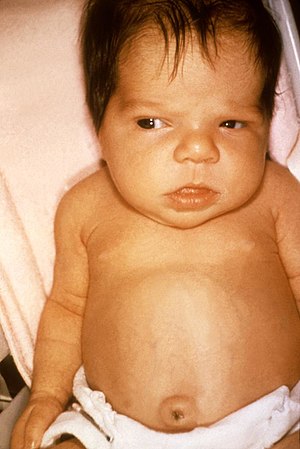Neonatal jaundice
| Neonatal jaundice | |
|---|---|
 |
|
| Jaundice in newborn | |
| Classification and external resources | |
| Specialty | Pediatrics |
| ICD-10 | P58, P59 |
| ICD-9-CM | 773, 774 |
| DiseasesDB | 8881 |
| MedlinePlus | 001559 |
| eMedicine | ped/1061 |
| Patient UK | Neonatal jaundice |
| MeSH | D007567 |
Neonatal jaundice or neonatal hyperbilirubinemia, or neonatal icterus (from the Greek word ἴκτερος), attributive adjective: icteric, is a yellowing of the skin and other tissues of a newborn infant. A bilirubin level of more than 85 μmol/l (5 mg/dL) leads to a jaundiced appearance in neonates whereas in adults a level of 34 μmol/l (2 mg/dL) is needed for this to occur. In newborns, jaundice is detected by blanching the skin with pressure applied by a finger so that it reveals underlying skin and subcutaneous tissue. Jaundiced newborns have yellow discoloration of the white part of the eye, and yellowing of the face, extending down onto the chest.
Neonatal jaundice can make the newborn sleepy and interfere with feeding. Extreme jaundice can cause permanent brain damage from kernicterus.
In neonates, the yellow discoloration of the skin is first noted in the face and as the bilirubin level rises proceeds caudal to the trunk and then to the extremities. This condition is common in newborns affecting over half (50–60%) of all babies in the first week of life.
Infants whose palms and soles are yellow, have serum bilirubin level over 255 μmol/l (15 mg/dL) (more serious level). Studies have shown that trained examiners assessment of levels of jaundice show moderate agreement with icterometer bilirubin measurements. In infants, jaundice can be measured using invasive or non-invasive methods.
In neonates, jaundice tends to develop because of two factors—the breakdown of fetal hemoglobin as it is replaced with adult hemoglobin and the relatively immature metabolic pathways of the liver, which are unable to conjugate and so excrete bilirubin as quickly as an adult. This causes an accumulation of bilirubin in the blood (hyperbilirubinemia), leading to the symptoms of jaundice.
If the neonatal jaundice does not clear up with simple phototherapy, other causes such as biliary atresia, Progressive familial intrahepatic cholestasis, bile duct paucity, Alagille syndrome, alpha 1-antitrypsin deficiency, and other pediatric liver diseases should be considered. The evaluation for these will include blood work and a variety of diagnostic tests. Prolonged neonatal jaundice is serious and should be followed up promptly.
...
Wikipedia
